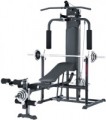Max. load weight
The largest weight of weights that can be installed on a machine of the appropriate design (see "Load").
When choosing according to this parameter, it is worth considering both the expected intensity of training and the characteristics of specific exercises. Detailed recommendations regarding this choice for different types of exercises are described in special sources. Here we emphasize that it is not recommended to exceed the maximum load weight: even if the machine does not break down immediately, an accident can occur at any time.
As for specific values, in most modern machines the permissible load weight
does not exceed 100 kg — this is often quite enough. There are also many models where this figure lies in the range of
100 – 150 kg; less common options for
150 – 200 kg; and in the most “heavyweight” models, it is allowed to use loads of
200 kg or more.
Max. barbell weight
The maximum weight of the barbell that the corresponding rack (if any, see above) can be guaranteed to carry — in other words, the maximum weight under which
the barbell rack will not break for a long time, comparable to the service life of the entire machine. It is not worth exceeding this weight, otherwise, a breakdown may occur at the most unexpected moment, and in the worst case, the consequences of this may be a serious injury.
Dimensions
The dimensions of the equipment in the assembled and ready-to-work state. It is important to note that more space is needed for the comfortable and proper operation of the machine. This is due to the need to have space for the athlete, and the arm and leg extensions when performing exercises and using additional equipment. If we are talking about a gym, then people working nearby or other equipment, etc., can become a hindrance. Therefore, it is recommended when choosing to calculate that in addition to the dimensions of the simulator, you may need an additional metre of free space on each side.

